Computex 2005 Early Bird Coverage: NVIDIA's G70, Athlon 64 BTX and more
by Anand Lal Shimpi on May 30, 2005 8:53 AM EST- Posted in
- Trade Shows
Tomorrow is the official start of this year's Computex, but as always we were able to get a sneak peak at the show before the floor actually opened.
With the show a day away from starting, we've already seen the first AMD BTX motherboard, a number of NVIDIA G70 graphics cards, an Intel motherboard that can be switched to an Socket-939 board by just purchasing a single card and the first hints of ATI's new multi-GPU chipset.
All of that and more in today's pre-show coverage.

BTX Athlon 64 Motherboard
Intel's BTX standard continues to be fairly unsupported by the motherboard manufacturers we've met with. The motherboard and case manufacturers that we've met with have told us that by the end of this year BTX shipments will account for under 10% of their overall production. By the end of 2006, that figure is expected to rise to anywhere between 15 - 30%. If you're worried about the transition to BTX, you probably won't be forced to migrate until 2007 - 2008.
One concern we have all voiced is the lack of AMD motherboard designs for the BTX specification. Originally we worried that routing would be an issue thanks to the Athlon 64's on-die memory controller, but MSI put our fears to rest by bringing us the first Socket-939 BTX motherboard we've ever seen:
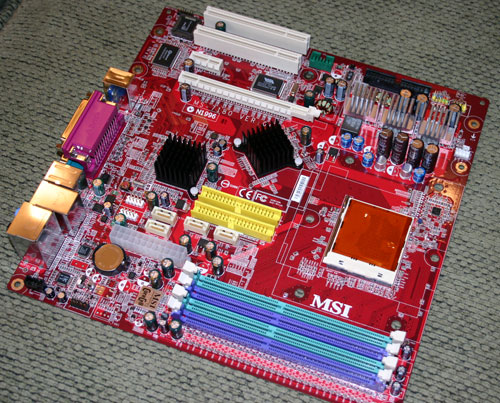
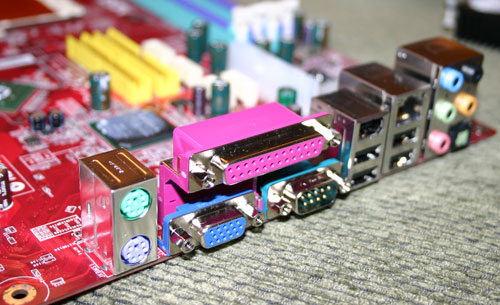
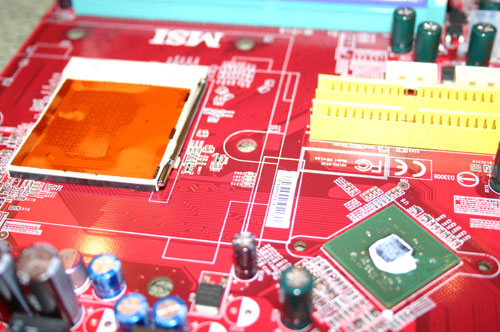
This particular board is based on NVIDIA's C51G integrated graphics chipset and adheres to the microBTX standard.
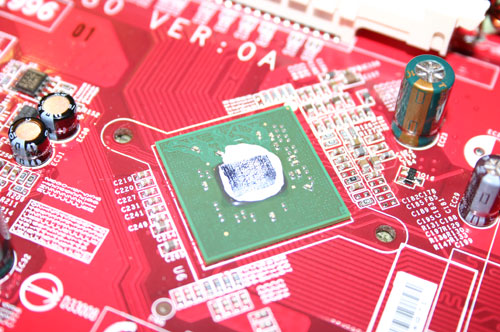
NVIDIA's C51G chipset - nForce4 + Integrated Graphics
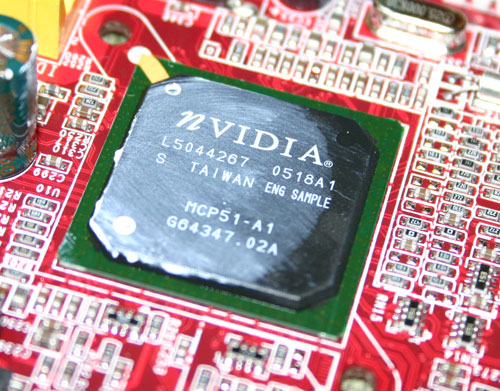
NVIDIA's C51G South Bridge, identical to what is on the nForce4 SLI Intel Edition
The board is due out for release by the end of this year, but it will be an OEM-only solution. MSI is demonstrating a total of two BTX motherboards at the show this year, which is a big increase from last year but in-line with the slow adoption rate we've seen for BTX.
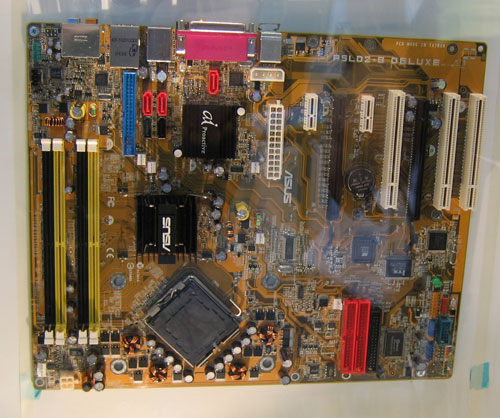
ASUS also had a few BTX motherboards at the show
The move to BTX is an expensive one for case manufacturers; the high costs of re-tooling and producing cases based on a new form factor have kept case manufacturers from embracing the new standard, especially given that ATX seems to be fulfilling users' needs just fine. The case manufacturers won't put much time and money behind BTX without widespread BTX motherboard availability, and motherboard manufacturers won't build BTX boards without widespread case availability. Like many new technologies in the PC industry, BTX presents both manufacturers with the classic chicken and egg scenario.










80 Comments
View All Comments
Anand Lal Shimpi - Monday, May 30, 2005 - link
justlyFor the most part, SiS chipsets are relegated to ultra low end solutions by motherboard manufacturers. There are times when SiS solutions are better suited for the enthusiast market, and whenever we do come across those chipsets we always present them to you all as best as possible (e.g. http://www.anandtech.com/mb/showdoc.aspx?i=2301).
There are always diamonds in the rough, and when we find them we do our best to present them. But when it comes to performance and solid drivers, it is really tough to beat the high end chipset makers right now - mainly Intel and NVIDIA (and potentially ATI).
That being said, I am working on a piece that will shed light on how the motherboard manufacturers and motherboard market view all of the chipset makers - you may be in for a bit of a surprise. More and more, ULi is looking like they may be the best kept secret of Taiwan. But more on that later :)
I'll pass on the positive comments about Gigabyte's solution on to the Gigabyte team here in Taiwan, I'm sure they'd love to hear it.
Take care,
Anand
cryptonomicon - Monday, May 30, 2005 - link
ramdrive looks sweetjustly - Monday, May 30, 2005 - link
42 - don't take this wrong, but if SiS, ULi (or any other chipset for that matter) is so "inferior in several areas of performance" then why do many articles (including Anandtechs) not make it clear that SiS (or any other chipset for that matter) have such limitations? I realize that SiS is not supirior in every aspect but when ever I see any article author confronted about chipsets (other than NVIDIA or Intel, and not just at Anandtech either) they all seem to throw off an aditude that "I know more than you" yet fail to give sound answers or links/proof of what they say. I for one can think for myself (I don't need to ask forum members to critique or pick out parts for my needs, I don't think most of them could since I am not a gamer) but I need the information to make a informed decission, and to put it bluntly your statement "inferior in several areas of performance" does not provide me with the information I need. If anything your answer just makes me more belligerent.Googer - Monday, May 30, 2005 - link
Corretion:Also Hopefuly gigabyte will release a motherboard just for this SSD drive. A motherboard that has one PCI slot that always recives power and remains powerd on at all times even when the PC is off, just for the support of this card only. Also it would be needed to have a bios option that would be able to turn this feature on or off, so that people who don't own one of these SSD's do not have a constantly powerd PCI slot when the pc is off.
Googer - Monday, May 30, 2005 - link
Also Hopefuly gigabyte will release a motherboard just for this one that has one PCI slot that remains powerd on at all times even when the PC is off, just for the support of this card only. Also it would be needed to have a bios option that would be able to turn this feature on or off, so that people who don't own one of these does not have a constantly powerd PCI slot.Googer - Monday, May 30, 2005 - link
The one advantage that the Cenetek Rocket Drive has over the gigabyte solution is the ability to recive power through an AC adapter that can be plugged in to the back of a nice BIG UPS.erwos - Monday, May 30, 2005 - link
I'm surprised Gigabyte didn't put a standard four-plug on the RAM board. That would allow for power during the time the computer was off (provided the PSU was receiving power).My guess is that it's intended for web servers, which have huge amounts of random accesses, but a reasonably low storage requirement. It would also be good for huge databases.
There's also the possibility of tossing a few of them into a RAID 5, with initial sync off a hard drive. That would quite handily alleviate storage requirements.
flatblastard - Monday, May 30, 2005 - link
Hmm...just remove the battery back-up from that ramdisk, and now you have yourself a drive that can store sensitive (illegal) data without much risk. You'd just need to be there to shut down the computer, or make it so the wrong keystrokes automatically shut it down when your not there. Back in my yonger days, I used ramdrive.sys for password cracking/encryption stuff all the time. Of course, that's back when 64MB of RAM was unheard of. Just an idea...JarredWalton - Monday, May 30, 2005 - link
30 - When actual tests back up the feeling that SiS chipsets (and ULi) are inferior in several areas of performance, such statements are not biased. There are many instances where SiS chipsets work fine, but to pretend that they are the equal of Intel is bias in the other direction.The real problem with that design is the cost of the upgrade boards. $50? There are cheap SiS-based boards for only slightly more than that. You deactivate the 775 socket and onboard memory in order to use the daughter card, so if you already had the board working, you now have at the very least an extra CPU sitting around. You also drop from four DIMM slots to two.
It's an interesting idea if you could make it work with the onboard RAM and sell the upgrade boards for much less than $50. At least, that's my opinion.
flatblastard - Monday, May 30, 2005 - link
#40 Christmas if yur lucky.